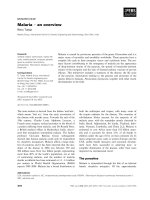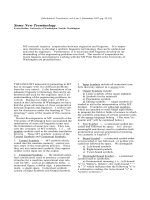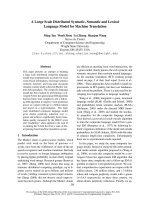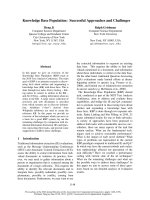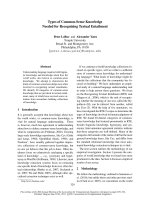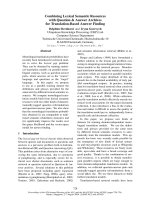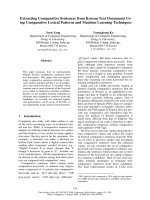Tài liệu Báo cáo khoa học: "LEXICAL KNOWLEDGE BASES" ppt
Bạn đang xem bản rút gọn của tài liệu. Xem và tải ngay bản đầy đủ của tài liệu tại đây (116.95 KB, 2 trang )
LEXICAL KNOWLEDGE
BASES
Robert A. Ameler
Natural-Lsngu.ge and Knowledge-Resource Systems
SRI International
Menlo Park, California 94025, USA
A lexical knowledge base is a repository of computational
information about concepts intended to be generally useful
in
many application areas including computational linguistics,
artificial intelligence, and information science. It contains
information derived from machine-readable dictionaries, the full
text of reference books, the results of statistical analyses of text
usages, and data manually obtained from human world
knowledge.
A lexical knowledge base is not intended to serve any one
application, but to be a general repository of knowledge about
lexical concepts and their relationships. Thus natural-language
parsers, generators, or other intelligent processors must be able
to interface to the knowledge base and are expected to only
extract those portions of its knowledge which they need for
specific tasks. Likewise, the knowledge base is designed, built,
and maintained primarily as a repository-rather than a tool
serving the needs of other computational processors. Just as
human memory, the knowledge base doesn't distinguish
between 'useful' knowledge and information for which it at
present doesn't have any functional use. In this manner the
knowledge base is a test bed for concept representation
mechanisms and data structures, rather than an adjunct to
other computational processes.
Investigations of machine-readable dictionaries over the last
decade have shown that they can be computationally useful for
tasks such as parsing, computer-assisted instruction, speech
generation, and content analysis. Sufficient knowledge of the
contents of machine-readable dictionaries now exists to provide
meaningful answers to questions concerning what additional
information about lexical concepts will be needed to represent
many aspects of human 'world knowledge.'
Machine-readable dictionaries are seen as providing an index
into human knowledge. A dictionary definition provides the
minimal information necessary to evoke the concept it defines
in the mind of a human reader who already knows to what this
concept refers. It is neither intended nor capable of serving as
the actual 'meaning' of that concept. A lexical knowledge base
is intended to provide a means of economically integrating not
only dictionary definitions, but other types of lexieal knowledge.
The task of constructing a lexical knowledge base is seen as a
goal in itself, distinct from the task of building natural language
processing programs that will use that knowledge base.
Several of the components of a lexical knowledge base are
already known and await assembly into one database. One
component is the tangled-hierarchy of concepts compiled as
part of an analysis of the kernels of the definitions in a
dictionary. This 'tangled' hierarchy provides ISA ares
connecting 27,000 nominal concepts and 12,000 verbal concepts
derived from the Merriam-Webster Pocket Dictionary [Amsler
1980]. Another component of the lexical knowledge base has
been provided by the extraction of subject codes from the
Longman Dictionary of Contemporary English. Some 17,000
concepts in the Longman dictionary possess subject designations
that give the domain in which these concepts are used.
There is a subtle distinction between the ISA hierarchy and
the subject classification that is worth mentioning. A word such
as 'crossbow' is taxonomically linked to 'weapon' in the ISA
hierarchy; but appears in the subject domain 'military history.'
Subjects thus do not duplicate ISA linkage information, but add
another facet to conceptual understanding.
There are a number of additional machine-readable
dictionary properties that can of course be combined into a
lexical knowledge base. Machine-readable dictionaries contain
information regarding the appropriate level of usage of
concepts; their geographic or chronologic associations; .and
semantic and syntactic restrictions on their potential arguments
and combinations.
In addition to this immediatly available information listed for
each concept in dictionary definitions, dictionaries contain
much implicit information derivable from studying collections
of definitions. For example, the verbs of motion can be analyzed
to reveal much more about their core concept 'move' than
would be seen from its definition alone.
Two major components of conceptual understanding which
dictionaries fail to adequately describe are procedural
knowledge and information derived from the mental inspection
of visual imagery. Sources for procedural knowledge may exist
in other types of special purpose reference books, such as
encyclopedias; but information derived from conceptual visual
images will require special encoding to be useful for
computational remsoning. Many questions of relative and
absolute size, position, and orientation are not answerable from
definitions. While some sizes are availab[e from reference
books, there nevertheless remain many aspects of our
understanding of tangible objects which can only be answered
by examination of illustrations or scenes in which the objects
appear.
Such illustrations are, however, an accepted part of many
458
dictionaries and other lexical reference books. The famous
'Duden' series of pictorial dictionaries provide line drawings and
illustrations of tangible objects, often collectively depicted in
scenes which relate large amounts of information about their
relative sizes, uses, etc. Such information will require encoding
methods that bridge the gap between natural language
understanding research and vision research.
Other line drawings often show the a series of images of
human figures going through the steps of an athletic event,
such as diving into a swimming pool, or performing a pole
vault. The information shown is chronological and spatial,
giving relative locations of the performer throughout time.
Capturing this pictorial information in a lexical knowledge base
will be necessary for it to contain the data needed to fully
understand text.
These tasks are seen as providing the basis for building
iexieal knowledge bases. The fundamental question governing
whether new information must be added to a lexical knowledge
base shall be whether natural-language understanding problems
demonstrate the need for the information and it can be shown
to not be inferrable from existing material in the knowledge
base.
[After July, 1984 the author will be joining the Artificial
Intelligence and Information Science Group at Bell
Communications Research in Morristown, New Jersey. Funding
for this paper was provided in part by NSF grants IST-8208578,
IST-8200346, and IST-8300040.]
459
